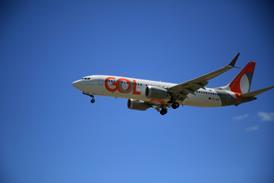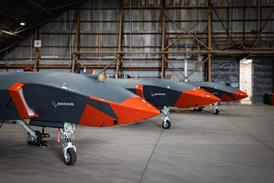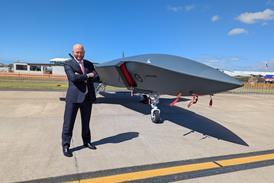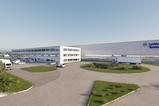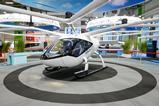In a low-slung factory hall just a stones’ throw from Europe’s largest nesting and hunting area for white storks, a new bird is coming to life under the watchful eyes and expert hands of a group of ambitious Swiss pilots and engineers.
Smartflyer’s SF-1 – a sleek, high-wing, tricycle-gear electric aircraft – seeks to revolutionise flight training, bringing down the cost, while also reducing noise pollution and fossil-fuel emissions.
At first glance, what stands out are the prominent, elongated nose, the smooth and light fiber composite fuselage, broad wraparound windows, and the forward-facing propeller on the empennage.
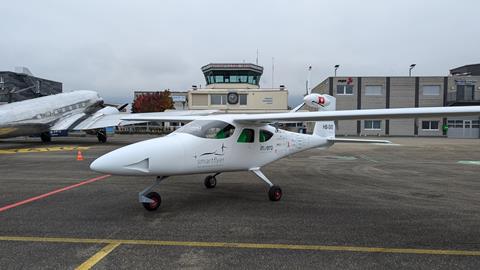
“It’s because of physics,” says Rolf Stuber, mastermind, founder, chief executive and head of design at Smartflyer. He too admits that the SF-1 requires some getting used to.
Stuber says he first saw the configuration on E-Genius, a light aircraft project that emerged from the Institute of Aircraft Design of Germany’s University of Stuttgart about 15 years ago. Its maiden flight was in 2011.
“I initially thought, ‘Those are idiots. So dumb. A propeller on the tail construction is the dumbest idea’. But then they explained it to me, and I thought, hm, maybe they are on to something.”
He also found inspiration in the Poeschel P300 Equator prototype: an amphibious aircraft of which three examples were built in the 1970s.
“I did some drawings and sketches, and I got to fly the E-Genius, and then I thought, ‘Okay that’s it, that’s the way it has to look, it has to be built this way’.”
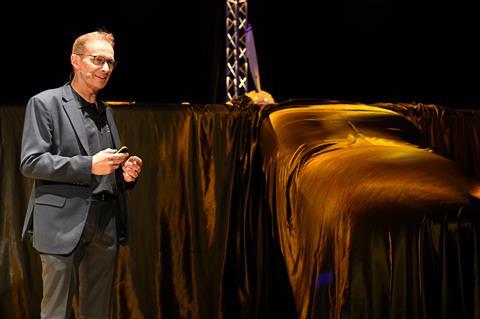
The SF-1 is a pretty stark departure from most single-engined piston trainers on the market today, but it is not just another such product. It is the first electric aircraft designed from the ground up for the electric motor, rather than it replacing a combustion engine.
Stuber, a former pilot for the Swiss air force and Swiss International Air Lines, took his cues from the glider world.
“A glider is basically maintenance-free,” he says. “You don’t have to do anything with it. On an aircraft, the only thing that requires maintenance is the combustion engine. That was the problem. We had to get rid of that.”
ELECTRIC DREAM
He was drawn to electric flight while still earning his keep in the left seat of Swiss’s Airbus A340s. Piloting the lumbering giant, often ridiculed by frequent flyers for its anemic climb rate, paid the bills. But in his free time, he began dreaming of and tinkering on his contribution to ‘Aviation 3.0’ – the electric aviation revolution.
The SF-1 looks sprightly and light, with its all-carbon construction, futuristic interior and intuitive avionics fitting right into today’s advanced aviation designs. But Stuber says the real innovation is under the hood.
“From the beginning we knew that the hybrid propulsion system was the core piece of the whole thing,” he says.
He founded Smartflyer in 2016, and along with a handful of fellow pilots, set about building the aircraft’s engine. It took four years of trial and error and testing to perfect the concept.
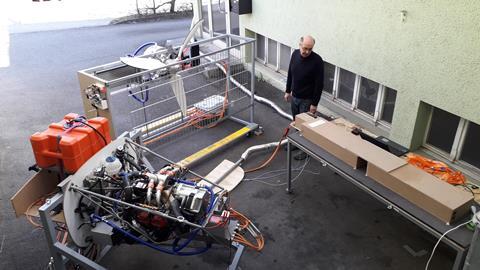
The pure electric engine, which is powered by high-capacity batteries, will provide an emissions-free endurance of 2.5h at 120kt (222km/h). Take-off power is 160kW, which translates to 215hp. Adding a range-extender – a small combustion engine that drives a generator to charge the batteries in-flight – will bring the range to about 432nm (800km).
Eventually, Stuber plans a fuel cell-powered variant with a flight endurance of more than 5h. The team promises a 25% reduction of emissions and 50% lower operating costs for potential flight school customers.
PLUG-AND-FLY
Stuber envisions a “plug-and-fly” concept. Swappable nose cones containing either the pure electric or range-extender propulsion units will be available and used according to what kind of flight is planned. Training flights in the airport environment, such as for touch-and-gos, would be done with the electric motor only, seeing as noise sensitivity is always an issue. Cross-country flights would be conducted with the range-extender. Charging can be done with a conventional 220V European socket.
He says that after some basic instruction, any pilot can safely switch out the modules in less than 15min. A flight school could, for example, purchase two electric engines and one range extender per airframe, which would allow the aircraft to be in operation and earning revenue all day.
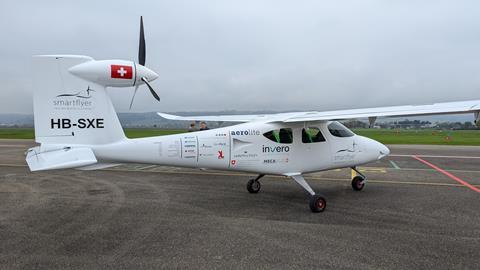
The propeller’s location on the tail is striking, but its positioning serves an important purpose. Stuber explains that the electric motor is “about five times lighter than a conventional combustion engine” and as such, designers were able to reconsider where the thrust would come from.
“We thought it would be best to put the propeller in the back, because the accelerated air mass can flow away freely and is not blocked by the broad fuselage cross-section if the prop were at the front.”
The cockpit controls and displays will be manageable and intuitive, and the wide windows give adequate visibility in all directions, including above the aircraft.

The current in-service training fleet, he says, is antiquated, expensive (due to increasing age and associated maintenance costs), and widely inaccessible due to the heavy financial burden of flight training – three factors that contribute to the world’s critical shortage of pilots.
He compares a 1968 Beech Bonanza to a 2024 Cirrus Aircraft SR-22 – both with the same Continental IO-550 engine – which serve similar purposes.
“The advancement in 50 years is that the Cirrus has a USB port and an air conditioner,” he says.
So why haven’t other OEMs figured this out yet?
“They can’t just take a regular airplane and put an electric motor in it. We are optimising all sorts of things, and building from scratch,” he says.
That optimisation, though, does not come cheap.
FUNDING SUPPORT
The Selzach-based company received support from a government fund financed by aviation fuel taxes, which promised the start-up up to 72% of its initial CHF4.1 million ($4.5 million) budget proposal. The funds were linked to milestones – which is where the innovators clashed hard with Swiss civil servants.
“From the beginning it was a difficult conversation,” he says. “It took a few years until we spoke the same language, and until they figured out what we were all about and what we needed.”
Stuber is not alone in expressing this annoyance. Countless European start-up CEOs before him have experienced the benefits of state support, but also confronted the aggravations and limitations of government bureaucracy. Over and over again, across the continent, entrepreneurs and innovators have complained about rigid guidelines and a lack of understanding for a new product, design or type.
In mid-2024, German electric vertical take-off and landing (eVTOL) developer Volocopter came up against this same issue when it was denied a government loan guarantee. Its then-chief executive Dirk Hoke considered insolvency, and complained that the lack of support for late-stage start-ups in Europe could lead to entrepreneurs moving their projects to more innovation-friendly locations.
That foot-dragging broke Volocopter’s competitor, Lilium, which was forced to declare insolvency in October 2024, and to seek buyers to pick up the pieces.
“We delivered thousands of pages of information to the authorities and met numerous regulatory milestones,” Stuber says. “The bureaucratic processes within the Federal Office make it impossible to handle a complex project that extends over several years.”
The fund suspended its support of Smartflyer in 2023. Of the promised CHF2.95 million, the company has so far received CHF1.4 million, and has taken legal action to recover the rest.
An external investor, Invero AG, provided CHF1 million, and Smartflyer is now on the hunt for another CHF1 million-plus it will need to complete its first test flight phase.
Certification under the European Union Aviation Safety Agency’s CS-23 rules will likely require another CHF25 million and five more years – a modest sum compared to the more-than-half-billion that eVTOL developers typically face.

“We are building a conventional aircraft, with conventional controls, but with the massive advantage of an electric propulsion system,” he says.
But while gathering the dossier of 4,500 pages to satisfy the Swiss civil aviation regulator was time-consuming at best and infuriating at worst, Stuber now knows that his aircraft design is sound.
“Compiling all the documents cost us time, but we have now proven that everything is certifiable, we have completed that step already,” he says. “That is very valuable. All the processes and information, we have everything that any other aircraft manufacturer has.”
The company’s timeline sees series aircraft production beginning in 2028, and first deliveries at the beginning of the next decade.
Stuber is convinced that the market potential is massive. He quotes a recent Airbus Global Services forecast which said that in the next 20 years the aviation industry will need an additional 680,000 technicians, 590,000 pilots and 920,000 cabin crew, totalling more than 2.2 million new skilled aviation professionals.
“The need for training aircraft is massive, especially in Asia,” he says. “That’s where growth will come from, and they will need modern equipment.”
READY TO FLY
The Smartflyer team presented its SF-1 to the world in November, at a glittery unveiling at Grenchen airport that was broadcast live on Swiss national television.
“We had to put a stake in the ground and say, ‘okay, we are ready to go’,” Stuber says. “The point was to show that we are beyond renderings, we are beyond concept studies, we have a real aircraft prototype to show, with everything installed. This bird is ready to fly.”
The biggest issue now is the high-voltage battery cells, which are expensive to acquire as they will be custom-made for the aircraft. The team has already completed a series of runaway thermal tests, as well as structural and load testing on the wing and tail construction.

Next June, Smartflyer will display its prototype on the Paris air show flight line in Le Bourget, in an attempt to attract the attention of major OEMs.
“Our priority now is to get this aircraft in the air, do the initial tests, so that we can prove it can perform,” he says. “That is our focus. After that when we have a package and can say, ‘here is the prototype, initial development is secured, performance is achieved’, that’s when we will hope to bring in industrial partners.”
Late next year a test campaign will begin at the military airfield in Payerne, half-way between Lausanne and Berne, which features a 9,000ft-long runway in a relatively sparsely populated part of west-central Switzerland. The SF-1’s maiden sortie is scheduled for “the fall”.
Eight years since work began, Stuber says Smartflyer’s journey has been an adventure, and that it is still fun. He is convinced that the industry is at the doorstep of an electric aviation breakthrough, with technical problems having been solved one after the other.
“Electric aviation is our future, and when people see how much more fun it is to fly, it will take off,” he says.
Solving those technical challenges was hard, with battery integration among the toughest nuts to crack. But the most difficult part for the start-up now is one that has flummoxed entrepreneurs and visionaries since time immemorial.
“Finding the money,” Stuber says with a laugh.



